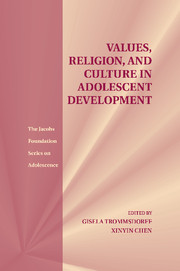Book contents
- Values, Religion, and Culture in Adolescent Development
- Series page
- Values, Religion, and Culture in Adolescent Development
- Copyright page
- Dedication
- Contents
- Contributors
- Preface
- Acknowledgments
- Part One Theoretical Perspectives on Values, Religion, and Adolescent Development in Cultural Context
- Part Two Universal and Culture-specific Functions of Adolescent Values and Religion
- Part Three Impact of Values and Religion on Adolescent Adjustment in Times of Social Change
- 9 Marginalized Japanese Youth in Post-industrial Japan
- 10 Adolescent Cultural Values and Adjustment in the Changing Chinese Society
- 11 With God’s Help
- 12 Religion’s Role in the Development of Girls’ Occupational Aspirations
- 13 First Romantic Relationships of Adolescents from Different Religious Groups in Israel and Germany
- Part Four Socialization Processes of Values and Religion in Adolescent Development
- Index
9 - Marginalized Japanese Youth in Post-industrial Japan
Motivational Patterns, Self-Perceptions, and the Structural Foundations of Shifting Values
from Part Three - Impact of Values and Religion on Adolescent Adjustment in Times of Social Change
Published online by Cambridge University Press: 05 September 2012
- Values, Religion, and Culture in Adolescent Development
- Series page
- Values, Religion, and Culture in Adolescent Development
- Copyright page
- Dedication
- Contents
- Contributors
- Preface
- Acknowledgments
- Part One Theoretical Perspectives on Values, Religion, and Adolescent Development in Cultural Context
- Part Two Universal and Culture-specific Functions of Adolescent Values and Religion
- Part Three Impact of Values and Religion on Adolescent Adjustment in Times of Social Change
- 9 Marginalized Japanese Youth in Post-industrial Japan
- 10 Adolescent Cultural Values and Adjustment in the Changing Chinese Society
- 11 With God’s Help
- 12 Religion’s Role in the Development of Girls’ Occupational Aspirations
- 13 First Romantic Relationships of Adolescents from Different Religious Groups in Israel and Germany
- Part Four Socialization Processes of Values and Religion in Adolescent Development
- Index
Summary
There is an increasing population of youth in Japan who are being pushed to the periphery of Japanese society. These include the NEETs (Not in Employment Education or Training), the Freeters (low-skill workers in highly insecure jobs), and the hikikomori (social isolates). We argue that Japanese youth marginalization has resulted, in large part, from economic and social structural changes in post-industrial Japan. We further argue that any discussion of values and motivational processes of youth should be examined within the context of the cultural and societal forces that are marginalizing many of them. In doing so, we compare at-risk youth with mainstream youth on independence and interdependence, post-materialist attitudes, and motivational styles. Additionally, we discuss the role that religion has played on helping youth transition into adulthood in the past versus in the present. Finally, we conclude the chapter by discussing the youth volunteer movement in the wake of the March 11, 2011 earthquake and what that might represent for the values and future of Japanese youth.
- Type
- Chapter
- Information
- Values, Religion, and Culture in Adolescent Development , pp. 211 - 234Publisher: Cambridge University PressPrint publication year: 2012
- 7
- Cited by



